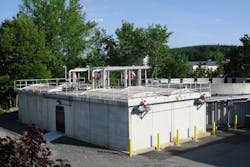Evoqua’s tech supplied to food-processing facility; Xylem opens St. Louis branch; Microvi demo shows nitrogen-removal results
Evoqua’s AnMBR technology to provide anaerobic wastewater treatment system for new food-processing facility
Evoqua Water Technologies’ ADI Systems announced the award of a design/build wastewater treatment project with Ken’s Foods, a producer of dressings, sauces and marinades, for its new food-processing facility in Lebanon, Indiana. Ken’s Foods once again chose the ADI anaerobic membrane bioreactor (AnMBR) treatment system based on the results at the Marlborough, Massachusetts, and McDonough, Georgia, processing facilities.
The AnMBR system combines anaerobic digestion with physical separation membranes, resulting in biodegradable organic removal and biogas production. In addition, the AnMBR offers a compact footprint, ideal for installations with limited available space on-site. Ken’s Foods’ treatment system will include a 2.2-million gallon anaerobic, continuously stirred-tank reactor, two 90,000-gallon anaerobic membrane tanks and a biogas collection, transmission and flare system. The treatment system is designed to produce a high-quality final effluent with very low chemical oxygen demand, biochemical oxygen demand, suspended solids and fat, oil and grease concentrations to meet the discharge limits of the publicly owned treatment works in a single anaerobic process step.
Xylem opens new water management branch in St. Louis
Xylem will open a new branch for water management solutions and applications in St. Louis, Missouri, managed by Greg Pritchett. It will include rental, sales and service for industrial, agricultural, mining, water utility, construction and general contracting applications with products from Godwin and Flygt brands. (Note: Flygt products can only be rented from the Xylem St. Louis branch.)
Microvi large-scale demonstration shows full nitrogen removal in less than two hours
Results from a large-scale demonstration of the Microvi MNE solution — installed in April 2018 at the Oro Loma Sanitary District in San Lorenzo, California — show that the combined nitrification-denitrification process can achieve effluent levels consistently below 3 mg/L and even as low as 1 mg/L TN from influent ammonia (NH3) concentrations as high as 45 mg/L. These results occur with a retention time of under two hours and little to no biosolids are produced. The next phase of the demonstration will focus on side-stream treatment of ammonia concentrations as high as 500 mg/L.
Microvi MNE combines Microvi Biotech Inc. technology with WesTech Engineering Inc. process equipment for a cost-effective approach to biological treatment. WesTech has an alliance agreement to commercialize the Microvi MNE solution for the water and wastewater industries.
This demonstration is a single-pass system that requires minimal operation time and maintenance, while eliminating the need for biosolids treatment and disposal. Customized integrations of the process for various applications have provided consistent BOD/COD removal, nitrification and denitrification. The process has a significantly smaller footprint, minimal biosolids production, reduced pumping requirements, and reduced energy costs. The solution is operator-friendly, stable, robust, and can be used in existing infrastructure. The Microvi technology uses novel biocatalytic composites (biocatalysts) that intensify biological processes, while maintaining a controlled population of targeted microorganisms at a higher density than existing technologies. Microvi’s technologies have been implemented in the U.S., Australia and the U.K. for drinking water, municipal wastewater, and industrial applications.
